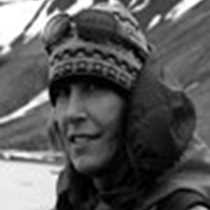Endicott Arm
It’s hard to imagine a better way to start a trip to Alaska than the dramatic fjord of Endicott Arm and its icy end, Dawes Glacier. Here, near the face of the glacier, the land is stripped of all its trappings. Sure, some mosses, grasses, and alder have taken hold on the newly-exposed rock, but not much. This is what we come here for: to find ourselves in a landscape that is utterly humbling.
We spent the morning spotting Arctic terns, bald eagles, mountain goats, and harbor seals, creatures that not only find this place tolerable but who call it home, cold and rough as it is. In addition to the wildlife, wilderness kayak rangers live here for much of the summer, and we were glad to welcome two of them aboard to share their experiences as keepers of the Ford’s Terror/Tracy Arm Wilderness Area.
On the trip out toward the entrance of Endicott Arm, a lone humpback was spotted. At first, it seemed quite sedate, rising and breathing in the still waters. Then, unexpectedly, it launched itself out of the water in a full three-quarter-turn breach. And again! After a few desultory tail-lobs, it continued its quiet progress and we were glad to watch that, too. The plumes of its breath hung in the calm air, mirrored by the breath of another whale a mile or so away.
We meant to hurry along to our afternoon anchorage, but a brown bear sow near the shore with her three yearling cubs stopped us. They ambled and shambled as we watched from the deck, speaking in whispers so as to not startle them into the woods.
Dropping anchor at Williams Cove, we set out in kayaks and on foot to experience a more intimate view of the rainforest. To pick up fallen lichen and get close to the many shades of green this forest has to offer, to get our boots into mud and our gear stained by salt from kayak paddles made the day and the place a bit more real. What a day… what an arrival in this huge, wild place.
It’s hard to imagine a better way to start a trip to Alaska than the dramatic fjord of Endicott Arm and its icy end, Dawes Glacier. Here, near the face of the glacier, the land is stripped of all its trappings. Sure, some mosses, grasses, and alder have taken hold on the newly-exposed rock, but not much. This is what we come here for: to find ourselves in a landscape that is utterly humbling.
We spent the morning spotting Arctic terns, bald eagles, mountain goats, and harbor seals, creatures that not only find this place tolerable but who call it home, cold and rough as it is. In addition to the wildlife, wilderness kayak rangers live here for much of the summer, and we were glad to welcome two of them aboard to share their experiences as keepers of the Ford’s Terror/Tracy Arm Wilderness Area.
On the trip out toward the entrance of Endicott Arm, a lone humpback was spotted. At first, it seemed quite sedate, rising and breathing in the still waters. Then, unexpectedly, it launched itself out of the water in a full three-quarter-turn breach. And again! After a few desultory tail-lobs, it continued its quiet progress and we were glad to watch that, too. The plumes of its breath hung in the calm air, mirrored by the breath of another whale a mile or so away.
We meant to hurry along to our afternoon anchorage, but a brown bear sow near the shore with her three yearling cubs stopped us. They ambled and shambled as we watched from the deck, speaking in whispers so as to not startle them into the woods.
Dropping anchor at Williams Cove, we set out in kayaks and on foot to experience a more intimate view of the rainforest. To pick up fallen lichen and get close to the many shades of green this forest has to offer, to get our boots into mud and our gear stained by salt from kayak paddles made the day and the place a bit more real. What a day… what an arrival in this huge, wild place.




